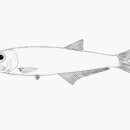Diagnostic Description
provided by Fishbase
Belly with 16 or 17 (rarely 19) + 9 to 11, total 26 to 28 (rarely 30) scutes. Lower jaw not strongly projecting; strong conical teeth in both jaws, continued as large and small teeth along maxilla blade. Easily recognized by large, canine-like teeth in both jaws (Ref. 26938). Dorsal fin origin behind midpoint of body; anal fin moderately long, its origin below or in front of dorsal fin origin.
- Recorder
- Crispina B. Binohlan
Morphology
provided by Fishbase
Dorsal spines (total): 0; Analspines: 0; Analsoft rays: 38 - 44
- Recorder
- Crispina B. Binohlan
Trophic Strategy
provided by Fishbase
In Southwestern Atlantic preys on proportionally large clupeoid fishes and caridean shrimps. Fishes are distinctively folded in the stomachs of this herring, in about 90% of the cases with their heads and tails pointing head-wards the predator. This herring stands out as the only small-sized species among the predaceous fish-eating clupeiforms. The well developed canine-like teeth are likely related to a piscivorous diet and may play a role in the folding and orientation of fish during prey handling and swallowing (Ref. 51383).
Biology
provided by Fishbase
Occurs in coastal areas, but also in lagoons and off river mouths, perhaps entering water of lowered salinity (Ref. 12225). In Southwestern Atlantic preys on proportionally large clupeoid fishes and caridean shrimps. Fishes are distinctively folded in the stomachs of this herring, in about 90% of the cases with their heads and tails pointing head-wards the predator. This herring stands out as the only small-sized species among the predaceous fish-eating clupeiforms. The well developed canine-like teeth are likely related to a piscivorous diet and may play a role in the folding and orientation of fish during prey handling and swallowing (Ref. 51383). Spawns during the northern winter (Ref. 37032).
- Recorder
- Crispina B. Binohlan
Importance
provided by Fishbase
fisheries: subsistence fisheries
- Recorder
- Crispina B. Binohlan
Dogtooth herring
provided by wikipedia EN
The dogtooth herring (Chirocentrodon bleekerianus) is a species of herring occurring in the Caribbean Sea and the Atlantic Ocean along the coast of northern South America, Central America and the Caribbean islands. It is the only species in its genus. They are commonly around 3.5 inches (9 cm) in length.
References

- license
- cc-by-sa-3.0
- copyright
- Wikipedia authors and editors
Dogtooth herring: Brief Summary
provided by wikipedia EN
The dogtooth herring (Chirocentrodon bleekerianus) is a species of herring occurring in the Caribbean Sea and the Atlantic Ocean along the coast of northern South America, Central America and the Caribbean islands. It is the only species in its genus. They are commonly around 3.5 inches (9 cm) in length.
- license
- cc-by-sa-3.0
- copyright
- Wikipedia authors and editors
Chirocentrodon bleekerianus
(
Basque
)
provided by wikipedia EU
(RLQ=window.RLQ||[]).push(function(){mw.log.warn("Gadget "ErrefAurrebista" was not loaded. Please migrate it to use ResourceLoader. See u003Chttps://eu.wikipedia.org/wiki/Berezi:Gadgetaku003E.");});
- license
- cc-by-sa-3.0
- copyright
- Wikipediako egileak eta editoreak
Chirocentrodon bleekerianus: Brief Summary
(
Basque
)
provided by wikipedia EU
Chirocentrodon bleekerianus Chirocentrodon generoko animalia da. Arrainen barruko Pristigasteridae familian sailkatzen da.
- license
- cc-by-sa-3.0
- copyright
- Wikipediako egileak eta editoreak
Chirocentrodon bleekerianus
(
Dutch; Flemish
)
provided by wikipedia NL
Vissen Chirocentrodon bleekerianus is een straalvinnige vissensoort uit de familie van haringen (Clupeidae).[2] De wetenschappelijke naam van de soort is voor het eerst geldig gepubliceerd in 1867 door Poey.
De soort staat op de Rode Lijst van de IUCN als niet bedreigd, beoordelingsjaar 2009.[1]
Bronnen, noten en/of referenties Geplaatst op:
22-10-2011
Dit artikel is een beginnetje over biologie. U wordt uitgenodigd om op bewerken te klikken om uw kennis aan dit artikel toe te voegen.

- license
- cc-by-sa-3.0
- copyright
- Wikipedia-auteurs en -editors
Chirocentrodon bleekerianus
(
Vietnamese
)
provided by wikipedia VI
Chirocentrodon bleekerianus[2] là một loài cá vây tia được Felipe Poey mô tả đầu tiên năm 1867. Chúng thuộc họ Clupeidae.[1][3][4]
Chú thích
- ^ a ă “Chirocentrodon bleekerianus”. Sách Đỏ IUCN các loài bị đe dọa. Phiên bản 2012.2. Liên minh Bảo tồn Thiên nhiên Quốc tế. 2010. Truy cập 24/10/2012. Kiểm tra giá trị ngày tháng trong:
|accessdate= (trợ giúp) - ^ a ă â b c d Whitehead, P.J.P. (1985) FAO Species Catalogue. Vol. 7. Clupeoid fishes of the world (suborder Clupeioidei). An annotated and illustrated catalogue of the herrings, sardines, pilchards, sprats, shads, anchovies and wolf-herrings., Part 1-Chirocentridae, Clupeidae and Pristigasteridae. FAO Fish. Synop. 125(7/1):1-303.
-
^ Bisby F.A., Roskov Y.R., Orrell T.M., Nicolson D., Paglinawan L.E., Bailly N., Kirk P.M., Bourgoin T., Baillargeon G., Ouvrard D. (red.) (2011). “Species 2000 & ITIS Catalogue of Life: 2011 Annual Checklist.”. Species 2000: Reading, UK. Truy cập ngày 24 tháng 9 năm 2012.
-
^ FishBase. Froese R. & Pauly D. (eds), 2011-06-14
Tham khảo
- license
- cc-by-sa-3.0
- copyright
- Wikipedia tác giả và biên tập viên
Chirocentrodon bleekerianus: Brief Summary
(
Vietnamese
)
provided by wikipedia VI
Chirocentrodon bleekerianus là một loài cá vây tia được Felipe Poey mô tả đầu tiên năm 1867. Chúng thuộc họ Clupeidae.
- license
- cc-by-sa-3.0
- copyright
- Wikipedia tác giả và biên tập viên
勃氏犬齒鰳
(
Chinese
)
provided by wikipedia 中文维基百科
勃氏犬齒鰳: Brief Summary
(
Chinese
)
provided by wikipedia 中文维基百科
勃氏犬齒鰳為輻鰭魚綱鲱形目鲱科的其中一種,分布於西大西洋區,包括加勒比海、巴西沿海海域,棲息深度20-60公尺,體長可達11公分,棲息在沿海海域、潟湖、河口區,成群活動,以浮游生物為食,繁殖期在冬季,可做為食用魚。

